Genre: Platform Developer: Blue Turtle Publisher: GameTek Players: 1 Released: 1994
As the number of games in the Mega Drive library that have yet to be reviewed at Sega-16 continues to dwindle, what remains increasingly share the same qualities. Of the releases outside Japan, they are either unremarkable games or terrible in a way that gives you a bad experience but not so bad as to inspire the muse to write a hateful review. Yogi Bear’s Cartoon Capers falls into the former category.
As told many times before, the early ’90s was a time when every recognisable anthropomorphic character new or old, was being hastily licensed for video games to cash in on the success of Sonic the Hedgehog. Yogi Bear was a natural choice as his cartoons were still being replayed on television (at least where I lived), and many children would have still recognised him. Yogi Bear’s Cartoon Capers came out in 1994, towards the end of this craze and in a year that saw the release of some of the best platformers of the 16-bit generation. This game would have had a hard time standing out even a few years earlier but had little chance in a year as full of significant releases as 1994 was. It should also be added that Cartoon Capers was only released stateside on the SNES and this was a PAL exclusive on the Mega Drive.
Cartoon Capers is a platformer, which will come as no surprise, and in most ways it is a very typical one. The game includes five areas that are each divided into four stages, and there are also two varieties of bonus stages. The areas all take place in Jellystone Park, beginning with a snowy mountain, through caves, a forest, a river and a construction site. The latter relates to the simple plot involving Yogi needing to save the park by stopping the construction of a chemical plant, an environmental trope more a product of the ’90s than the source material. The game does also feature an overworld, and stages can be replayed though there is no save or password feature included. There are also no options and pressing start will take you straight to the game. It isn’t a particularly long or complicated game, so these features aren’t necessary though a password feature for each area at least would have been welcome.
If you know Yogi Bear even vaguely, you know he likes picnic baskets, or more precisely the content of the picnic baskets. It won’t be surprising to learn that picnic baskets feature heavily in the game. In fact, they are absolutely everywhere. They are also one of the few unique features of the game, as Yogi collect’s them by jumping on them. Jumping on successive picnic baskets gives a higher score for successive jumps. The baskets are always in lines, clusters, or some other arrangement to facilitate this. They also play a part in the vertical gameplay since each stage has multiple levels to traverse and they are often used to cross pits or reach higher plains. The other prominent collectables are clocks that are almost as plentiful as the picnic baskets. Collecting one hundred will grant an extra life (though I never did), but they are chiefly used to add time in the bonus stages found in each stage in the form of a bed. Jumping on the bed will land Yogi in a dream world where he can collect pizzas, hamburgers, and (what I assume are) very large potato chips. At the end of these you will find a piece of a clock and collecting four will earn you a continue. These must be collected in one area though, as once you move to the next area you’ll have to collect four all over again.
Before moving to a new area there is another bonus stage which marks the only appearance of other characters from the cartoon, Boo-Boo and Ranger Smith. Yogi is standing in the street and has to catch food (in his mouth) thrown by Boo-Boo from windows while avoiding dynamite thrown by Ranger Smith. Getting through this nets you an extra life but these stages get increasingly difficult, and I found even the first one more difficult than any stage in the main game, making the reward rather redundant.
Yogi’s only method of attack is jumping, so the player won’t just be jumping on picnic baskets and over platforms. There are a large variety of enemies and they are all well-animated (as I should add, is Yogi himself). Most of them are animals, but there are also some human enemies, and the bunnies were a personal favourite that I tended to avoid jumping upon. There are some new enemies introduced in each area, but many also return throughout the game. When jumped upon they will run away, which I assume was done to tone down the violence inherent in vanishing in a puffy cloud or being comically flattened. For the most part, the enemies are not major obstacles to progress as health (in the form of a cake) is generous and plentiful, as always should be the case with cake. Getting hit will lose a slice, but this slice can be chased down and restored — if you are quick, which is another one of the unique features of the game. The main dangers are the bottomless pits that are present in all areas except the water-based fourth area. As mentioned earlier, there are usually ways to travel upwards and the best tactic is to stay as high as you can in each stage until you reach the “Don’t Feed the Bears” sign that marks the end.
With twenty levels and five unique areas there is still a remarkable lack of variety. I would be hard pressed to identify a difference between any of the four stages for each area, and I noticed that some parts were repeated in stages. The caves stage has some brief mine cart sections where Yogi simply has to duck low-hanging wooden beams to get through unscathed. The fourth area introduces swimming, along with brief rides on gophers across water and that’s about it. The vast majority of the game is going from left to right jumping on picnic baskets, enemies, and collecting clocks. Each area quickly becomes monotonous to the point where I feel the developers would have done much better to half the total stages and put more effort into differentiating the remaining ten.
The final area of the game at the construction site is fittingly the most difficult, but this is due more to confusing foreground objects than any genuine challenge. This is also the area where players will most want to heed my advice to stay as high as they can because pitfalls are far more common. Disappointingly, the fourth stage of the final area ends exactly as the previous nineteen did, without a boss or anything to give the game a satisfying end. You get a brief splash screen, the credits, and then it’s back to the overworld screen. There is really nothing to it, which also helpfully makes for a good description of the game as a whole.
Before closing, I should comment on the visuals and sound. As mentioned, the character art and animation are a definite highlight. The levels themselves are mostly colourful, but the background layers are usually sparse. There is some voice work of Yogi that thankfully isn’t overused to the point where it becomes irritating. The music is mostly upbeat but hearing the same tune for four stages usually wears out each tracks welcome.
Yogi Bear’s Cartoon Capers has some good ideas, and those that like pursuing high scores might find more to like than those who play platform games more casually. For its time, there were far worse games you could have been given by grandma, but it would have been a very unlikely choice to make over Earthworm Jim or Sonic & Knuckles the year it released. Today, it might be an interesting game to try one lazy afternoon or for those interested in the source material, though even then there isn’t much of the cartoon represented outside Yogi himself. Yogi Berra (whose similar name is a total coincidence according to Hanna-Barbara), once said, “We made too many wrong mistakes.” That’s what this game did and to end with a word from Yogi Bear, it is strictly an “av-er-age” game as a result.

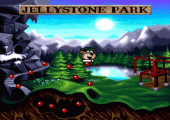
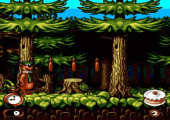
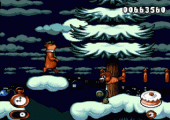
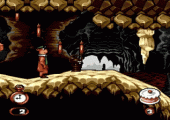
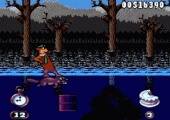
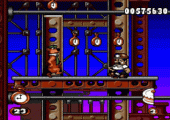
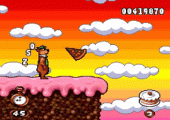
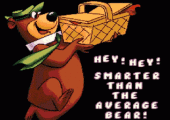
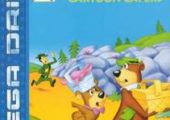
Recent Comments